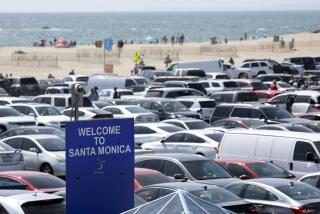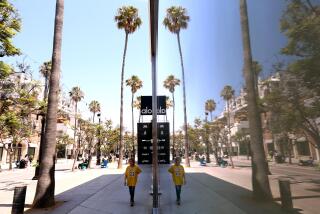Opinion: Why Santa Monica got rid of parking minimums downtown. And why other cities should consider following suit
Santa Monica has long strived to be one of the most walkable places in Southern California. Policies to make downtown a pedestrian-centric walking district have been in effect since the 1970s, when Santa Monica pioneered the “park once” strategy, with centralized public parking structures that made it easy for people to leave their cars behind while they walked to multiple activities.
Like most cities that were developed in the mid-part of the last century, however, an abundance of low-cost parking and limited public transit connections made the car king.
That’s slowly changing. Santa Monica now has a diverse transportation system with 60,000 daily Expo Line riders, 10,000 daily downtown rides on Big Blue Bus and SoCal’s first bike share system, Breeze.
It’s time for the city to take things even further. Sixty-four percent of our carbon emissions come from transportation. We can’t reduce our footprint and do our part to fight climate change without driving less.
So, over the summer, the City Council decided to eliminate minimum parking requirements on new development in downtown Santa Monica.
Here’s why: Parking has a much broader impact on a city than you might expect. It’s expensive to build, it incentivizes car travel over public and active transportation, and it’s been built with abandon, especially in Southern California. Studies show drivers are more open to using public transit, walking or cycling when there’s less access to cheap and easy parking.
For decades, before lifting this requirement, developers in downtown Santa Monica were required to provide, on average, one or more parking spaces for every unit of housing and approximately three parking spaces for every 1,000 square feet of space run by a new business.
But guess what? Downtown Santa Monica already has approximately 10,000 parking spaces. And much of it isn’t used efficiently. By one estimate from a downtown local hotel manager, only 17% of its parking is used when the hotel reaches 85 percent occupancy.
Parking spaces that go unused aren’t just futile and environmentally unfriendly — they’re expensive and are worsening California’s housing crisis. A single parking spot adds 12.5% to the price of an apartment.
By not requiring new parking, we can lower the overall cost to build new housing, remove barriers to opening businesses, spur the creative reuse of existing buildings and encourage drivers to more efficiently use the spaces that already exist.
Adding density without demanding an abundance of cheap and easy parking may sound revolutionary in car-centric California, yet there are districts throughout the state and around the country — including most major cities in Texas — that have done so in their downtown areas to allow for historic preservation and more flexible new development.
Naturally, this idea isn’t without controversy. It’s our attempt at a “grand bargain” — addressing the divide between slow-growth advocates and those who feel that transit-rich downtown Santa Monica is the best place to build taller and faster to address the region’s housing shortage.
We have no illusions that Santa Monica will solve the regional housing crisis or eliminate all traffic congestion, but we are going to find out exactly how this kind of parking reform allows the market to innovate with housing design and adaptive reuse.
We hope the rest of L.A. County will take note of our experiment. We certainly aren’t the only city to suffer from the burdens of excessive parking mandates.
Southern California’s environment and our shared future depend on getting people out of cars and into alternative forms of transit. Urban areas need to make better use of existing parking spaces and focus economic investment on what we really need: housing.
We believe Santa Monica can accomplish these goals, accommodate the next generation of residents, encourage more sustainable lifestyles and still retain the character of the city we love. This is the challenge facing all cities. While there are growing pains associated with creating this future, we’re compelled to do it. For Santa Monica to stay livable, we have to try.
Our priority is clear: downtown is for people first.
Ted Winterer is the mayor of Santa Monica
Follow the Opinion section on Twitter @latimesopinion or Facebook
More to Read
A cure for the common opinion
Get thought-provoking perspectives with our weekly newsletter.
You may occasionally receive promotional content from the Los Angeles Times.










